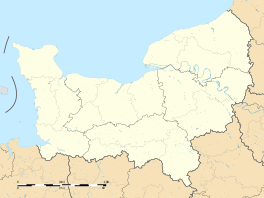Fecamp
| Fécamp | ||
|---|---|---|

The port and the city
|
||
|
||
| Coordinates: 49°46′N 0°23′E / 49.76°N 0.38°ECoordinates: 49°46′N 0°23′E / 49.76°N 0.38°E | ||
| Country | France | |
| Region | Normandy | |
| Department | Seine-Maritime | |
| Arrondissement | Le Havre | |
| Canton | Fécamp | |
| Government | ||
| • Mayor (2014–2020) | Marie-Agnès Poussier-Winsback | |
| Area1 | 15.07 km2 (5.82 sq mi) | |
| Population (2013)2 | 19,381 | |
| • Density | 1,300/km2 (3,300/sq mi) | |
| Time zone | CET (UTC+1) | |
| • Summer (DST) | CEST (UTC+2) | |
| INSEE/Postal code | 76259 / 76400 | |
| Elevation | 0–125 m (0–410 ft) (avg. 14 m or 46 ft) |
|
|
1 French Land Register data, which excludes lakes, ponds, glaciers > 1 km² (0.386 sq mi or 247 acres) and river estuaries. 2Population without double counting: residents of multiple communes (e.g., students and military personnel) only counted once. |
||
1 French Land Register data, which excludes lakes, ponds, glaciers > 1 km² (0.386 sq mi or 247 acres) and river estuaries.
Fécamp is a commune in the Seine-Maritime department in the Haute-Normandie region in northern France.
Fécamp is situated in the valley of the Valmont river, at the heart of the Pays de Caux, on the Albaster Coast. It is around 35 km northeast of Le Havre, and around 60 km northwest of Rouen.
According to its late medieval founding legend, the trunk of a fig tree (ficus) carrying the Precious Blood of Christ collected by Joseph of Arimathea was washed ashore on the riverbank at Fécamp in the 1st century. Immediately, a fountain of holy blood gushed from the site; the relic attracted many medieval pilgrims, enhancing the reputation of the city.
The monks' legend justified the artificial etymology of the name to Fici-campus, the camp of the fig tree. Fécamp, however, is mentioned in 875 as Fiscannum and in 990 as Fiscannus and as late as 1496 which stem from the Germanic root fisc (English "fish") with an unknown suffix. It used to be the name of the Valmont River.
The prehistoric site, on the high ground inland from the port of Fécamp, reveals human occupation dating back to Neolithic times. Spreading over 21 hectares, surrounded by walls and ditches for a length of nearly 2000 meters, including a praetorian door. Objects recovered range in date from the Neolithic until Roman times.
...
Wikipedia



